ACC518 - Evaluating Accounting Thought: Historical Cost and Framework
VerifiedAdded on 2023/04/20
|7
|3124
|425
Essay
AI Summary
This essay critically evaluates historical cost information in accounting, addressing its relevance issues during rising prices and comparing it with alternatives like fair value accounting. It explores the role of conceptual frameworks in enhancing financial reporting legitimacy, questioning whether their primary purpose is to boost the accounting profession's public standing or to improve the decision-usefulness of financial reports for investors. The essay also discusses the shift towards fair value in accounting standards and the need for a robust measurement basis within conceptual frameworks to overcome the limitations of historical cost, emphasizing decision-usefulness and investor protection. Desklib provides resources for students, including similar essays and study tools.
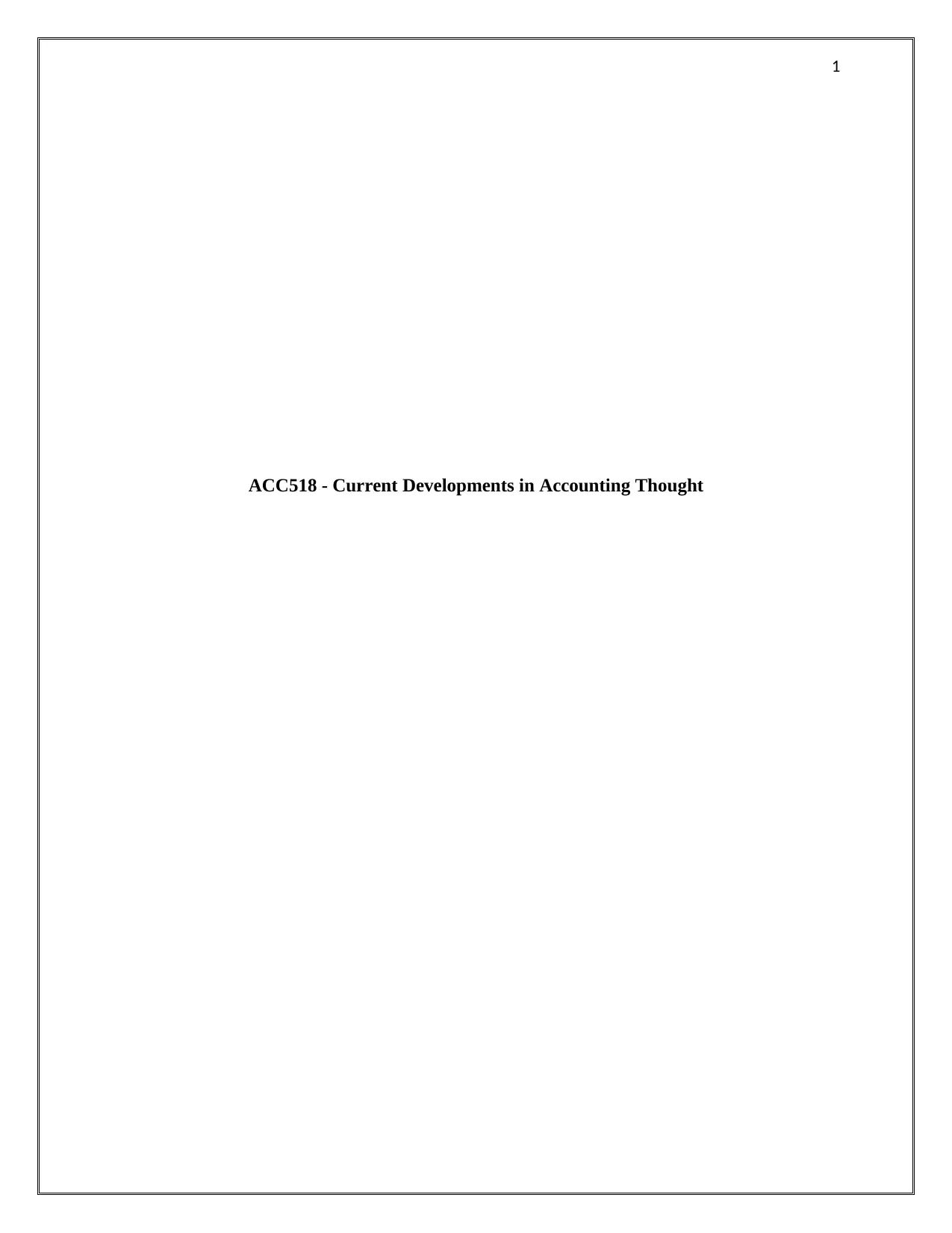
1
ACC518 - Current Developments in Accounting Thought
ACC518 - Current Developments in Accounting Thought
Paraphrase This Document
Need a fresh take? Get an instant paraphrase of this document with our AI Paraphraser
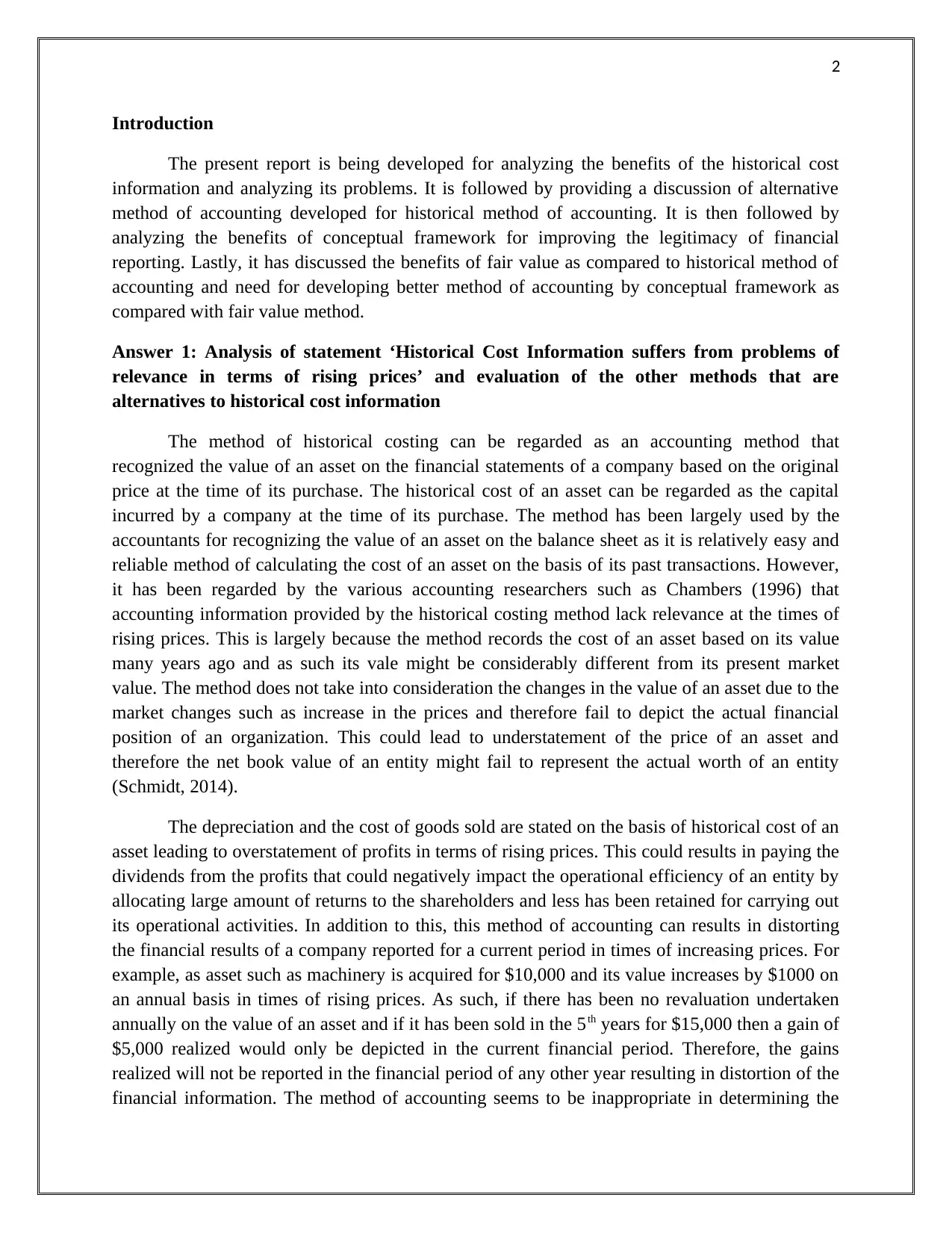
2
Introduction
The present report is being developed for analyzing the benefits of the historical cost
information and analyzing its problems. It is followed by providing a discussion of alternative
method of accounting developed for historical method of accounting. It is then followed by
analyzing the benefits of conceptual framework for improving the legitimacy of financial
reporting. Lastly, it has discussed the benefits of fair value as compared to historical method of
accounting and need for developing better method of accounting by conceptual framework as
compared with fair value method.
Answer 1: Analysis of statement ‘Historical Cost Information suffers from problems of
relevance in terms of rising prices’ and evaluation of the other methods that are
alternatives to historical cost information
The method of historical costing can be regarded as an accounting method that
recognized the value of an asset on the financial statements of a company based on the original
price at the time of its purchase. The historical cost of an asset can be regarded as the capital
incurred by a company at the time of its purchase. The method has been largely used by the
accountants for recognizing the value of an asset on the balance sheet as it is relatively easy and
reliable method of calculating the cost of an asset on the basis of its past transactions. However,
it has been regarded by the various accounting researchers such as Chambers (1996) that
accounting information provided by the historical costing method lack relevance at the times of
rising prices. This is largely because the method records the cost of an asset based on its value
many years ago and as such its vale might be considerably different from its present market
value. The method does not take into consideration the changes in the value of an asset due to the
market changes such as increase in the prices and therefore fail to depict the actual financial
position of an organization. This could lead to understatement of the price of an asset and
therefore the net book value of an entity might fail to represent the actual worth of an entity
(Schmidt, 2014).
The depreciation and the cost of goods sold are stated on the basis of historical cost of an
asset leading to overstatement of profits in terms of rising prices. This could results in paying the
dividends from the profits that could negatively impact the operational efficiency of an entity by
allocating large amount of returns to the shareholders and less has been retained for carrying out
its operational activities. In addition to this, this method of accounting can results in distorting
the financial results of a company reported for a current period in times of increasing prices. For
example, as asset such as machinery is acquired for $10,000 and its value increases by $1000 on
an annual basis in times of rising prices. As such, if there has been no revaluation undertaken
annually on the value of an asset and if it has been sold in the 5th years for $15,000 then a gain of
$5,000 realized would only be depicted in the current financial period. Therefore, the gains
realized will not be reported in the financial period of any other year resulting in distortion of the
financial information. The method of accounting seems to be inappropriate in determining the
Introduction
The present report is being developed for analyzing the benefits of the historical cost
information and analyzing its problems. It is followed by providing a discussion of alternative
method of accounting developed for historical method of accounting. It is then followed by
analyzing the benefits of conceptual framework for improving the legitimacy of financial
reporting. Lastly, it has discussed the benefits of fair value as compared to historical method of
accounting and need for developing better method of accounting by conceptual framework as
compared with fair value method.
Answer 1: Analysis of statement ‘Historical Cost Information suffers from problems of
relevance in terms of rising prices’ and evaluation of the other methods that are
alternatives to historical cost information
The method of historical costing can be regarded as an accounting method that
recognized the value of an asset on the financial statements of a company based on the original
price at the time of its purchase. The historical cost of an asset can be regarded as the capital
incurred by a company at the time of its purchase. The method has been largely used by the
accountants for recognizing the value of an asset on the balance sheet as it is relatively easy and
reliable method of calculating the cost of an asset on the basis of its past transactions. However,
it has been regarded by the various accounting researchers such as Chambers (1996) that
accounting information provided by the historical costing method lack relevance at the times of
rising prices. This is largely because the method records the cost of an asset based on its value
many years ago and as such its vale might be considerably different from its present market
value. The method does not take into consideration the changes in the value of an asset due to the
market changes such as increase in the prices and therefore fail to depict the actual financial
position of an organization. This could lead to understatement of the price of an asset and
therefore the net book value of an entity might fail to represent the actual worth of an entity
(Schmidt, 2014).
The depreciation and the cost of goods sold are stated on the basis of historical cost of an
asset leading to overstatement of profits in terms of rising prices. This could results in paying the
dividends from the profits that could negatively impact the operational efficiency of an entity by
allocating large amount of returns to the shareholders and less has been retained for carrying out
its operational activities. In addition to this, this method of accounting can results in distorting
the financial results of a company reported for a current period in times of increasing prices. For
example, as asset such as machinery is acquired for $10,000 and its value increases by $1000 on
an annual basis in times of rising prices. As such, if there has been no revaluation undertaken
annually on the value of an asset and if it has been sold in the 5th years for $15,000 then a gain of
$5,000 realized would only be depicted in the current financial period. Therefore, the gains
realized will not be reported in the financial period of any other year resulting in distortion of the
financial information. The method of accounting seems to be inappropriate in determining the
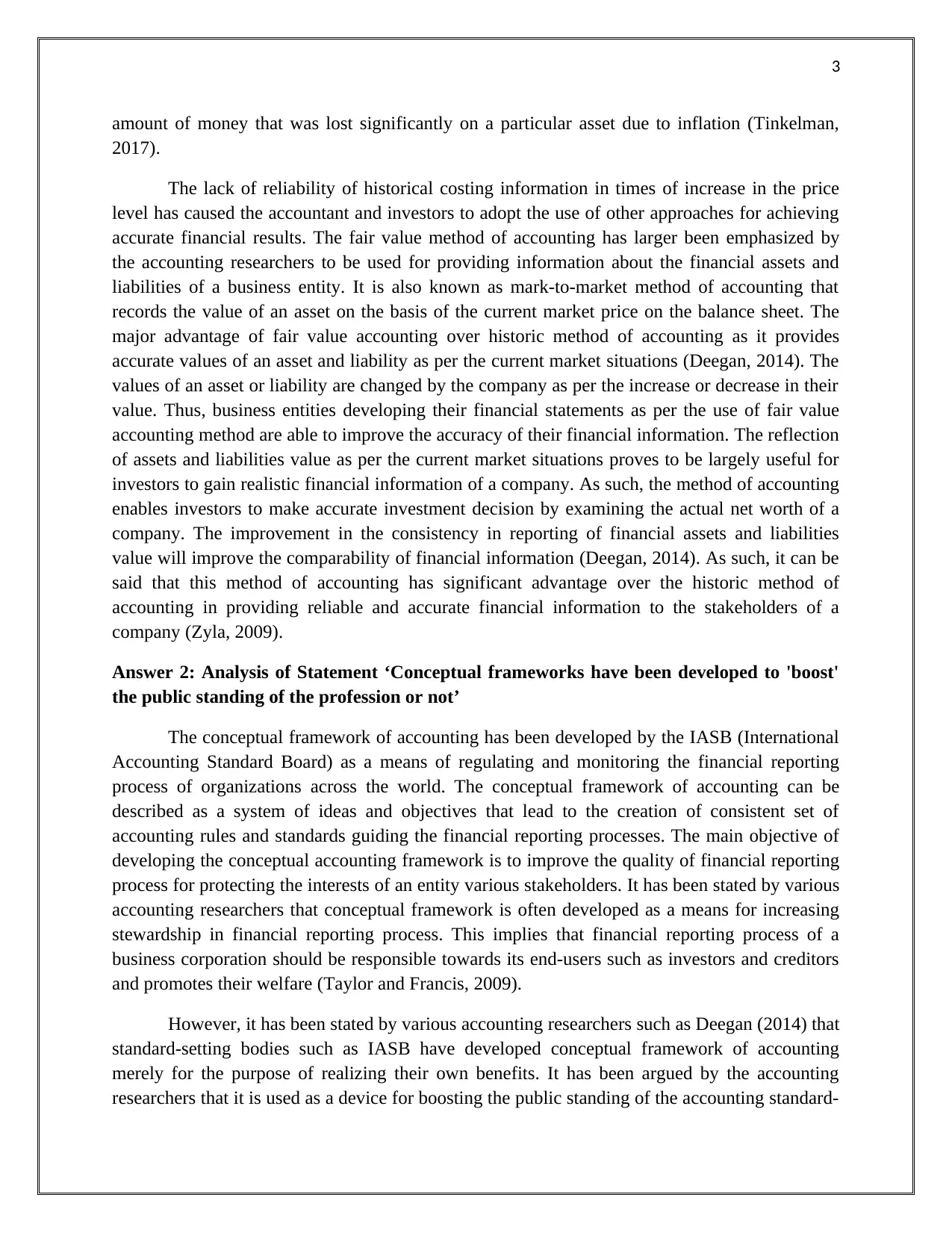
3
amount of money that was lost significantly on a particular asset due to inflation (Tinkelman,
2017).
The lack of reliability of historical costing information in times of increase in the price
level has caused the accountant and investors to adopt the use of other approaches for achieving
accurate financial results. The fair value method of accounting has larger been emphasized by
the accounting researchers to be used for providing information about the financial assets and
liabilities of a business entity. It is also known as mark-to-market method of accounting that
records the value of an asset on the basis of the current market price on the balance sheet. The
major advantage of fair value accounting over historic method of accounting as it provides
accurate values of an asset and liability as per the current market situations (Deegan, 2014). The
values of an asset or liability are changed by the company as per the increase or decrease in their
value. Thus, business entities developing their financial statements as per the use of fair value
accounting method are able to improve the accuracy of their financial information. The reflection
of assets and liabilities value as per the current market situations proves to be largely useful for
investors to gain realistic financial information of a company. As such, the method of accounting
enables investors to make accurate investment decision by examining the actual net worth of a
company. The improvement in the consistency in reporting of financial assets and liabilities
value will improve the comparability of financial information (Deegan, 2014). As such, it can be
said that this method of accounting has significant advantage over the historic method of
accounting in providing reliable and accurate financial information to the stakeholders of a
company (Zyla, 2009).
Answer 2: Analysis of Statement ‘Conceptual frameworks have been developed to 'boost'
the public standing of the profession or not’
The conceptual framework of accounting has been developed by the IASB (International
Accounting Standard Board) as a means of regulating and monitoring the financial reporting
process of organizations across the world. The conceptual framework of accounting can be
described as a system of ideas and objectives that lead to the creation of consistent set of
accounting rules and standards guiding the financial reporting processes. The main objective of
developing the conceptual accounting framework is to improve the quality of financial reporting
process for protecting the interests of an entity various stakeholders. It has been stated by various
accounting researchers that conceptual framework is often developed as a means for increasing
stewardship in financial reporting process. This implies that financial reporting process of a
business corporation should be responsible towards its end-users such as investors and creditors
and promotes their welfare (Taylor and Francis, 2009).
However, it has been stated by various accounting researchers such as Deegan (2014) that
standard-setting bodies such as IASB have developed conceptual framework of accounting
merely for the purpose of realizing their own benefits. It has been argued by the accounting
researchers that it is used as a device for boosting the public standing of the accounting standard-
amount of money that was lost significantly on a particular asset due to inflation (Tinkelman,
2017).
The lack of reliability of historical costing information in times of increase in the price
level has caused the accountant and investors to adopt the use of other approaches for achieving
accurate financial results. The fair value method of accounting has larger been emphasized by
the accounting researchers to be used for providing information about the financial assets and
liabilities of a business entity. It is also known as mark-to-market method of accounting that
records the value of an asset on the basis of the current market price on the balance sheet. The
major advantage of fair value accounting over historic method of accounting as it provides
accurate values of an asset and liability as per the current market situations (Deegan, 2014). The
values of an asset or liability are changed by the company as per the increase or decrease in their
value. Thus, business entities developing their financial statements as per the use of fair value
accounting method are able to improve the accuracy of their financial information. The reflection
of assets and liabilities value as per the current market situations proves to be largely useful for
investors to gain realistic financial information of a company. As such, the method of accounting
enables investors to make accurate investment decision by examining the actual net worth of a
company. The improvement in the consistency in reporting of financial assets and liabilities
value will improve the comparability of financial information (Deegan, 2014). As such, it can be
said that this method of accounting has significant advantage over the historic method of
accounting in providing reliable and accurate financial information to the stakeholders of a
company (Zyla, 2009).
Answer 2: Analysis of Statement ‘Conceptual frameworks have been developed to 'boost'
the public standing of the profession or not’
The conceptual framework of accounting has been developed by the IASB (International
Accounting Standard Board) as a means of regulating and monitoring the financial reporting
process of organizations across the world. The conceptual framework of accounting can be
described as a system of ideas and objectives that lead to the creation of consistent set of
accounting rules and standards guiding the financial reporting processes. The main objective of
developing the conceptual accounting framework is to improve the quality of financial reporting
process for protecting the interests of an entity various stakeholders. It has been stated by various
accounting researchers that conceptual framework is often developed as a means for increasing
stewardship in financial reporting process. This implies that financial reporting process of a
business corporation should be responsible towards its end-users such as investors and creditors
and promotes their welfare (Taylor and Francis, 2009).
However, it has been stated by various accounting researchers such as Deegan (2014) that
standard-setting bodies such as IASB have developed conceptual framework of accounting
merely for the purpose of realizing their own benefits. It has been argued by the accounting
researchers that it is used as a device for boosting the public standing of the accounting standard-
⊘ This is a preview!⊘
Do you want full access?
Subscribe today to unlock all pages.

Trusted by 1+ million students worldwide
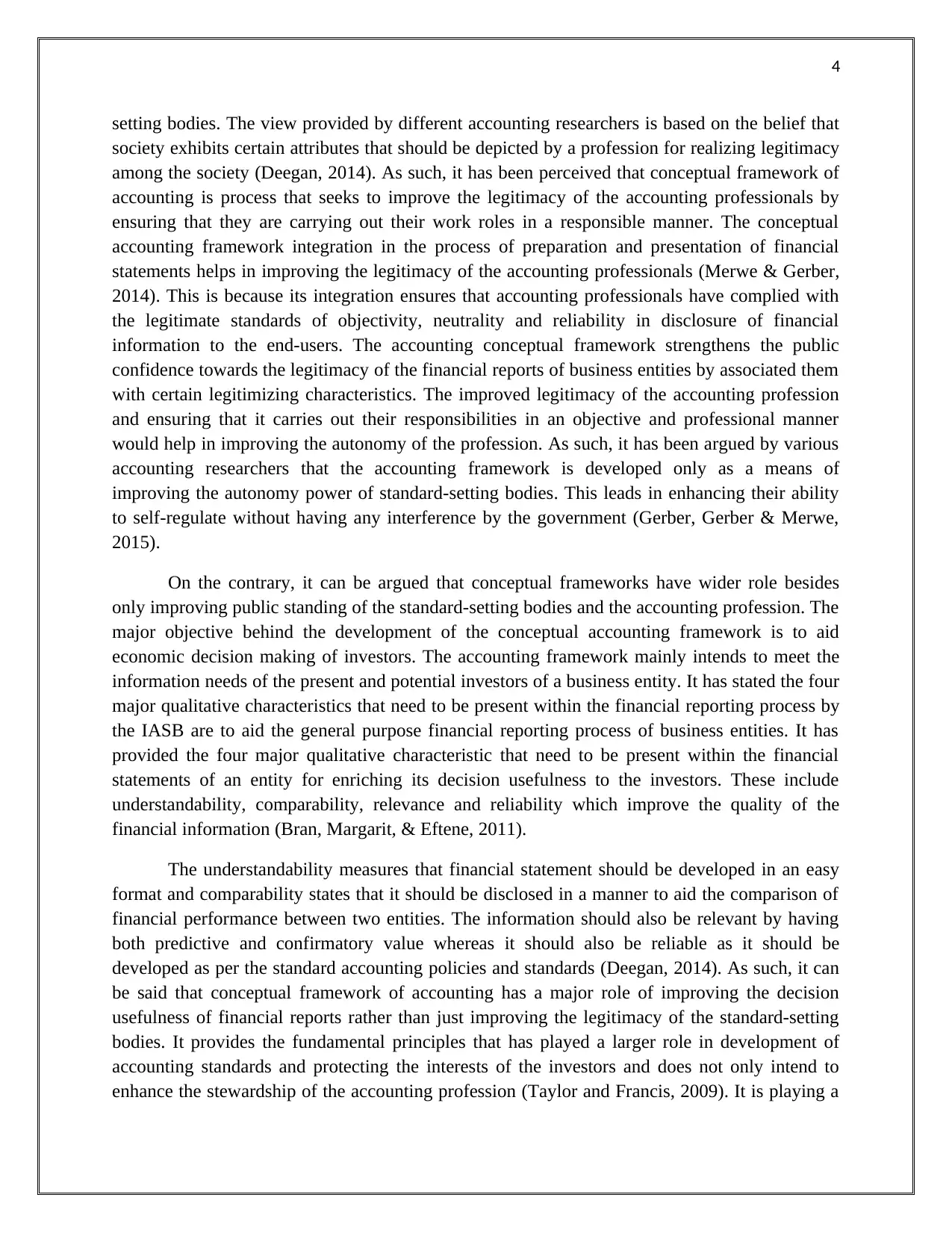
4
setting bodies. The view provided by different accounting researchers is based on the belief that
society exhibits certain attributes that should be depicted by a profession for realizing legitimacy
among the society (Deegan, 2014). As such, it has been perceived that conceptual framework of
accounting is process that seeks to improve the legitimacy of the accounting professionals by
ensuring that they are carrying out their work roles in a responsible manner. The conceptual
accounting framework integration in the process of preparation and presentation of financial
statements helps in improving the legitimacy of the accounting professionals (Merwe & Gerber,
2014). This is because its integration ensures that accounting professionals have complied with
the legitimate standards of objectivity, neutrality and reliability in disclosure of financial
information to the end-users. The accounting conceptual framework strengthens the public
confidence towards the legitimacy of the financial reports of business entities by associated them
with certain legitimizing characteristics. The improved legitimacy of the accounting profession
and ensuring that it carries out their responsibilities in an objective and professional manner
would help in improving the autonomy of the profession. As such, it has been argued by various
accounting researchers that the accounting framework is developed only as a means of
improving the autonomy power of standard-setting bodies. This leads in enhancing their ability
to self-regulate without having any interference by the government (Gerber, Gerber & Merwe,
2015).
On the contrary, it can be argued that conceptual frameworks have wider role besides
only improving public standing of the standard-setting bodies and the accounting profession. The
major objective behind the development of the conceptual accounting framework is to aid
economic decision making of investors. The accounting framework mainly intends to meet the
information needs of the present and potential investors of a business entity. It has stated the four
major qualitative characteristics that need to be present within the financial reporting process by
the IASB are to aid the general purpose financial reporting process of business entities. It has
provided the four major qualitative characteristic that need to be present within the financial
statements of an entity for enriching its decision usefulness to the investors. These include
understandability, comparability, relevance and reliability which improve the quality of the
financial information (Bran, Margarit, & Eftene, 2011).
The understandability measures that financial statement should be developed in an easy
format and comparability states that it should be disclosed in a manner to aid the comparison of
financial performance between two entities. The information should also be relevant by having
both predictive and confirmatory value whereas it should also be reliable as it should be
developed as per the standard accounting policies and standards (Deegan, 2014). As such, it can
be said that conceptual framework of accounting has a major role of improving the decision
usefulness of financial reports rather than just improving the legitimacy of the standard-setting
bodies. It provides the fundamental principles that has played a larger role in development of
accounting standards and protecting the interests of the investors and does not only intend to
enhance the stewardship of the accounting profession (Taylor and Francis, 2009). It is playing a
setting bodies. The view provided by different accounting researchers is based on the belief that
society exhibits certain attributes that should be depicted by a profession for realizing legitimacy
among the society (Deegan, 2014). As such, it has been perceived that conceptual framework of
accounting is process that seeks to improve the legitimacy of the accounting professionals by
ensuring that they are carrying out their work roles in a responsible manner. The conceptual
accounting framework integration in the process of preparation and presentation of financial
statements helps in improving the legitimacy of the accounting professionals (Merwe & Gerber,
2014). This is because its integration ensures that accounting professionals have complied with
the legitimate standards of objectivity, neutrality and reliability in disclosure of financial
information to the end-users. The accounting conceptual framework strengthens the public
confidence towards the legitimacy of the financial reports of business entities by associated them
with certain legitimizing characteristics. The improved legitimacy of the accounting profession
and ensuring that it carries out their responsibilities in an objective and professional manner
would help in improving the autonomy of the profession. As such, it has been argued by various
accounting researchers that the accounting framework is developed only as a means of
improving the autonomy power of standard-setting bodies. This leads in enhancing their ability
to self-regulate without having any interference by the government (Gerber, Gerber & Merwe,
2015).
On the contrary, it can be argued that conceptual frameworks have wider role besides
only improving public standing of the standard-setting bodies and the accounting profession. The
major objective behind the development of the conceptual accounting framework is to aid
economic decision making of investors. The accounting framework mainly intends to meet the
information needs of the present and potential investors of a business entity. It has stated the four
major qualitative characteristics that need to be present within the financial reporting process by
the IASB are to aid the general purpose financial reporting process of business entities. It has
provided the four major qualitative characteristic that need to be present within the financial
statements of an entity for enriching its decision usefulness to the investors. These include
understandability, comparability, relevance and reliability which improve the quality of the
financial information (Bran, Margarit, & Eftene, 2011).
The understandability measures that financial statement should be developed in an easy
format and comparability states that it should be disclosed in a manner to aid the comparison of
financial performance between two entities. The information should also be relevant by having
both predictive and confirmatory value whereas it should also be reliable as it should be
developed as per the standard accounting policies and standards (Deegan, 2014). As such, it can
be said that conceptual framework of accounting has a major role of improving the decision
usefulness of financial reports rather than just improving the legitimacy of the standard-setting
bodies. It provides the fundamental principles that has played a larger role in development of
accounting standards and protecting the interests of the investors and does not only intend to
enhance the stewardship of the accounting profession (Taylor and Francis, 2009). It is playing a
Paraphrase This Document
Need a fresh take? Get an instant paraphrase of this document with our AI Paraphraser
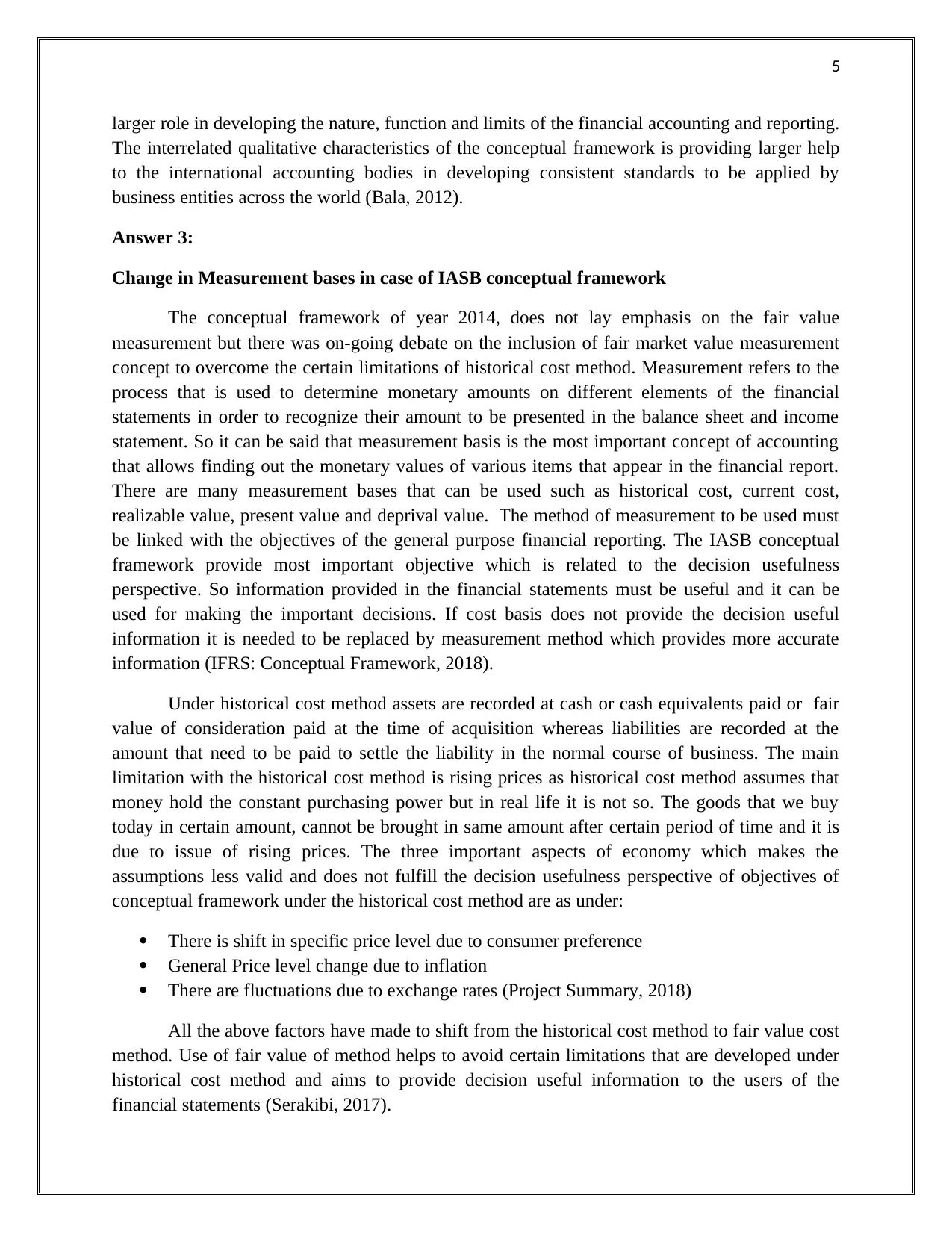
5
larger role in developing the nature, function and limits of the financial accounting and reporting.
The interrelated qualitative characteristics of the conceptual framework is providing larger help
to the international accounting bodies in developing consistent standards to be applied by
business entities across the world (Bala, 2012).
Answer 3:
Change in Measurement bases in case of IASB conceptual framework
The conceptual framework of year 2014, does not lay emphasis on the fair value
measurement but there was on-going debate on the inclusion of fair market value measurement
concept to overcome the certain limitations of historical cost method. Measurement refers to the
process that is used to determine monetary amounts on different elements of the financial
statements in order to recognize their amount to be presented in the balance sheet and income
statement. So it can be said that measurement basis is the most important concept of accounting
that allows finding out the monetary values of various items that appear in the financial report.
There are many measurement bases that can be used such as historical cost, current cost,
realizable value, present value and deprival value. The method of measurement to be used must
be linked with the objectives of the general purpose financial reporting. The IASB conceptual
framework provide most important objective which is related to the decision usefulness
perspective. So information provided in the financial statements must be useful and it can be
used for making the important decisions. If cost basis does not provide the decision useful
information it is needed to be replaced by measurement method which provides more accurate
information (IFRS: Conceptual Framework, 2018).
Under historical cost method assets are recorded at cash or cash equivalents paid or fair
value of consideration paid at the time of acquisition whereas liabilities are recorded at the
amount that need to be paid to settle the liability in the normal course of business. The main
limitation with the historical cost method is rising prices as historical cost method assumes that
money hold the constant purchasing power but in real life it is not so. The goods that we buy
today in certain amount, cannot be brought in same amount after certain period of time and it is
due to issue of rising prices. The three important aspects of economy which makes the
assumptions less valid and does not fulfill the decision usefulness perspective of objectives of
conceptual framework under the historical cost method are as under:
There is shift in specific price level due to consumer preference
General Price level change due to inflation
There are fluctuations due to exchange rates (Project Summary, 2018)
All the above factors have made to shift from the historical cost method to fair value cost
method. Use of fair value of method helps to avoid certain limitations that are developed under
historical cost method and aims to provide decision useful information to the users of the
financial statements (Serakibi, 2017).
larger role in developing the nature, function and limits of the financial accounting and reporting.
The interrelated qualitative characteristics of the conceptual framework is providing larger help
to the international accounting bodies in developing consistent standards to be applied by
business entities across the world (Bala, 2012).
Answer 3:
Change in Measurement bases in case of IASB conceptual framework
The conceptual framework of year 2014, does not lay emphasis on the fair value
measurement but there was on-going debate on the inclusion of fair market value measurement
concept to overcome the certain limitations of historical cost method. Measurement refers to the
process that is used to determine monetary amounts on different elements of the financial
statements in order to recognize their amount to be presented in the balance sheet and income
statement. So it can be said that measurement basis is the most important concept of accounting
that allows finding out the monetary values of various items that appear in the financial report.
There are many measurement bases that can be used such as historical cost, current cost,
realizable value, present value and deprival value. The method of measurement to be used must
be linked with the objectives of the general purpose financial reporting. The IASB conceptual
framework provide most important objective which is related to the decision usefulness
perspective. So information provided in the financial statements must be useful and it can be
used for making the important decisions. If cost basis does not provide the decision useful
information it is needed to be replaced by measurement method which provides more accurate
information (IFRS: Conceptual Framework, 2018).
Under historical cost method assets are recorded at cash or cash equivalents paid or fair
value of consideration paid at the time of acquisition whereas liabilities are recorded at the
amount that need to be paid to settle the liability in the normal course of business. The main
limitation with the historical cost method is rising prices as historical cost method assumes that
money hold the constant purchasing power but in real life it is not so. The goods that we buy
today in certain amount, cannot be brought in same amount after certain period of time and it is
due to issue of rising prices. The three important aspects of economy which makes the
assumptions less valid and does not fulfill the decision usefulness perspective of objectives of
conceptual framework under the historical cost method are as under:
There is shift in specific price level due to consumer preference
General Price level change due to inflation
There are fluctuations due to exchange rates (Project Summary, 2018)
All the above factors have made to shift from the historical cost method to fair value cost
method. Use of fair value of method helps to avoid certain limitations that are developed under
historical cost method and aims to provide decision useful information to the users of the
financial statements (Serakibi, 2017).
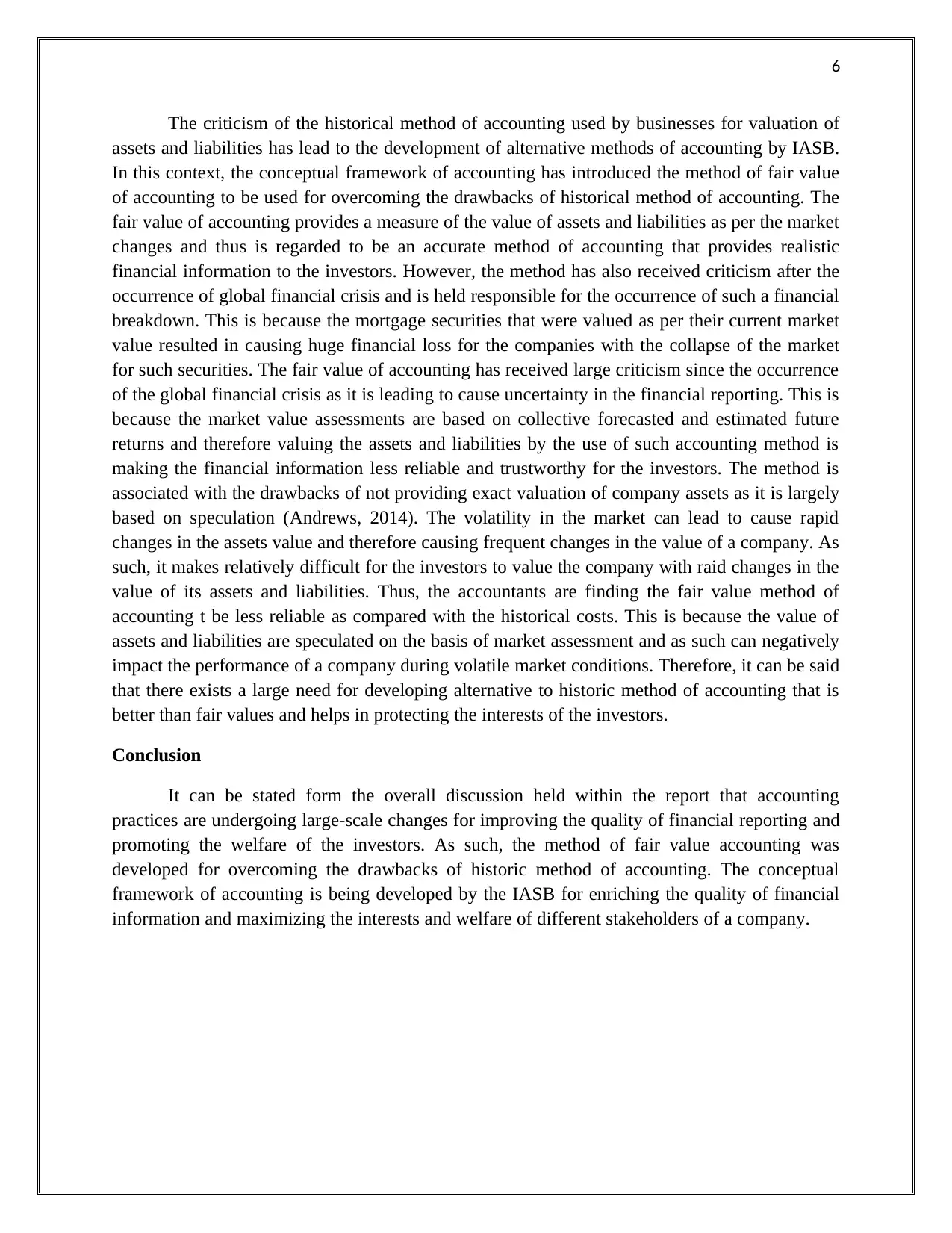
6
The criticism of the historical method of accounting used by businesses for valuation of
assets and liabilities has lead to the development of alternative methods of accounting by IASB.
In this context, the conceptual framework of accounting has introduced the method of fair value
of accounting to be used for overcoming the drawbacks of historical method of accounting. The
fair value of accounting provides a measure of the value of assets and liabilities as per the market
changes and thus is regarded to be an accurate method of accounting that provides realistic
financial information to the investors. However, the method has also received criticism after the
occurrence of global financial crisis and is held responsible for the occurrence of such a financial
breakdown. This is because the mortgage securities that were valued as per their current market
value resulted in causing huge financial loss for the companies with the collapse of the market
for such securities. The fair value of accounting has received large criticism since the occurrence
of the global financial crisis as it is leading to cause uncertainty in the financial reporting. This is
because the market value assessments are based on collective forecasted and estimated future
returns and therefore valuing the assets and liabilities by the use of such accounting method is
making the financial information less reliable and trustworthy for the investors. The method is
associated with the drawbacks of not providing exact valuation of company assets as it is largely
based on speculation (Andrews, 2014). The volatility in the market can lead to cause rapid
changes in the assets value and therefore causing frequent changes in the value of a company. As
such, it makes relatively difficult for the investors to value the company with raid changes in the
value of its assets and liabilities. Thus, the accountants are finding the fair value method of
accounting t be less reliable as compared with the historical costs. This is because the value of
assets and liabilities are speculated on the basis of market assessment and as such can negatively
impact the performance of a company during volatile market conditions. Therefore, it can be said
that there exists a large need for developing alternative to historic method of accounting that is
better than fair values and helps in protecting the interests of the investors.
Conclusion
It can be stated form the overall discussion held within the report that accounting
practices are undergoing large-scale changes for improving the quality of financial reporting and
promoting the welfare of the investors. As such, the method of fair value accounting was
developed for overcoming the drawbacks of historic method of accounting. The conceptual
framework of accounting is being developed by the IASB for enriching the quality of financial
information and maximizing the interests and welfare of different stakeholders of a company.
The criticism of the historical method of accounting used by businesses for valuation of
assets and liabilities has lead to the development of alternative methods of accounting by IASB.
In this context, the conceptual framework of accounting has introduced the method of fair value
of accounting to be used for overcoming the drawbacks of historical method of accounting. The
fair value of accounting provides a measure of the value of assets and liabilities as per the market
changes and thus is regarded to be an accurate method of accounting that provides realistic
financial information to the investors. However, the method has also received criticism after the
occurrence of global financial crisis and is held responsible for the occurrence of such a financial
breakdown. This is because the mortgage securities that were valued as per their current market
value resulted in causing huge financial loss for the companies with the collapse of the market
for such securities. The fair value of accounting has received large criticism since the occurrence
of the global financial crisis as it is leading to cause uncertainty in the financial reporting. This is
because the market value assessments are based on collective forecasted and estimated future
returns and therefore valuing the assets and liabilities by the use of such accounting method is
making the financial information less reliable and trustworthy for the investors. The method is
associated with the drawbacks of not providing exact valuation of company assets as it is largely
based on speculation (Andrews, 2014). The volatility in the market can lead to cause rapid
changes in the assets value and therefore causing frequent changes in the value of a company. As
such, it makes relatively difficult for the investors to value the company with raid changes in the
value of its assets and liabilities. Thus, the accountants are finding the fair value method of
accounting t be less reliable as compared with the historical costs. This is because the value of
assets and liabilities are speculated on the basis of market assessment and as such can negatively
impact the performance of a company during volatile market conditions. Therefore, it can be said
that there exists a large need for developing alternative to historic method of accounting that is
better than fair values and helps in protecting the interests of the investors.
Conclusion
It can be stated form the overall discussion held within the report that accounting
practices are undergoing large-scale changes for improving the quality of financial reporting and
promoting the welfare of the investors. As such, the method of fair value accounting was
developed for overcoming the drawbacks of historic method of accounting. The conceptual
framework of accounting is being developed by the IASB for enriching the quality of financial
information and maximizing the interests and welfare of different stakeholders of a company.
⊘ This is a preview!⊘
Do you want full access?
Subscribe today to unlock all pages.

Trusted by 1+ million students worldwide
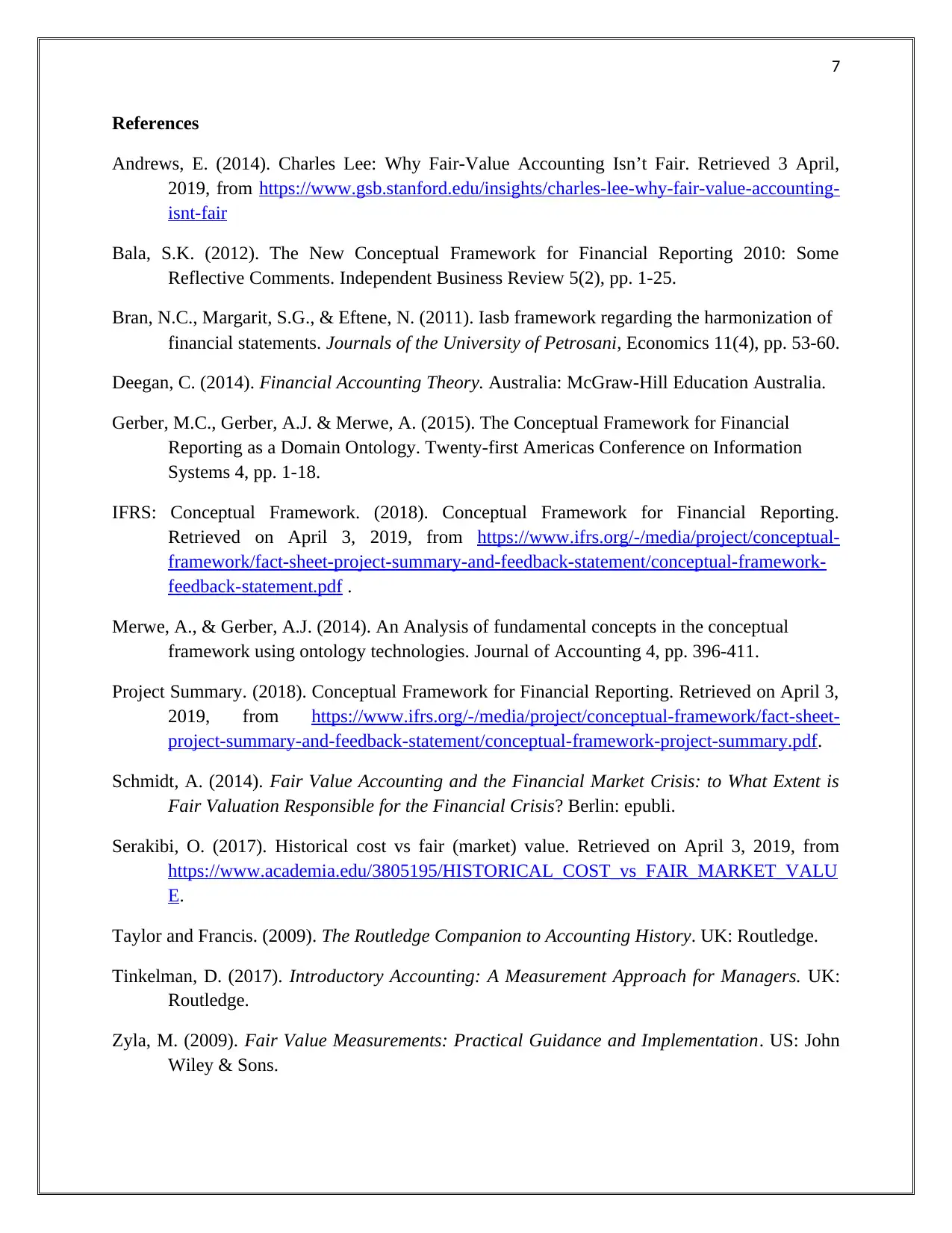
7
References
Andrews, E. (2014). Charles Lee: Why Fair-Value Accounting Isn’t Fair. Retrieved 3 April,
2019, from https://www.gsb.stanford.edu/insights/charles-lee-why-fair-value-accounting-
isnt-fair
Bala, S.K. (2012). The New Conceptual Framework for Financial Reporting 2010: Some
Reflective Comments. Independent Business Review 5(2), pp. 1-25.
Bran, N.C., Margarit, S.G., & Eftene, N. (2011). Iasb framework regarding the harmonization of
financial statements. Journals of the University of Petrosani, Economics 11(4), pp. 53-60.
Deegan, C. (2014). Financial Accounting Theory. Australia: McGraw-Hill Education Australia.
Gerber, M.C., Gerber, A.J. & Merwe, A. (2015). The Conceptual Framework for Financial
Reporting as a Domain Ontology. Twenty-first Americas Conference on Information
Systems 4, pp. 1-18.
IFRS: Conceptual Framework. (2018). Conceptual Framework for Financial Reporting.
Retrieved on April 3, 2019, from https://www.ifrs.org/-/media/project/conceptual-
framework/fact-sheet-project-summary-and-feedback-statement/conceptual-framework-
feedback-statement.pdf .
Merwe, A., & Gerber, A.J. (2014). An Analysis of fundamental concepts in the conceptual
framework using ontology technologies. Journal of Accounting 4, pp. 396-411.
Project Summary. (2018). Conceptual Framework for Financial Reporting. Retrieved on April 3,
2019, from https://www.ifrs.org/-/media/project/conceptual-framework/fact-sheet-
project-summary-and-feedback-statement/conceptual-framework-project-summary.pdf.
Schmidt, A. (2014). Fair Value Accounting and the Financial Market Crisis: to What Extent is
Fair Valuation Responsible for the Financial Crisis? Berlin: epubli.
Serakibi, O. (2017). Historical cost vs fair (market) value. Retrieved on April 3, 2019, from
https://www.academia.edu/3805195/HISTORICAL_COST_vs_FAIR_MARKET_VALU
E.
Taylor and Francis. (2009). The Routledge Companion to Accounting History. UK: Routledge.
Tinkelman, D. (2017). Introductory Accounting: A Measurement Approach for Managers. UK:
Routledge.
Zyla, M. (2009). Fair Value Measurements: Practical Guidance and Implementation. US: John
Wiley & Sons.
References
Andrews, E. (2014). Charles Lee: Why Fair-Value Accounting Isn’t Fair. Retrieved 3 April,
2019, from https://www.gsb.stanford.edu/insights/charles-lee-why-fair-value-accounting-
isnt-fair
Bala, S.K. (2012). The New Conceptual Framework for Financial Reporting 2010: Some
Reflective Comments. Independent Business Review 5(2), pp. 1-25.
Bran, N.C., Margarit, S.G., & Eftene, N. (2011). Iasb framework regarding the harmonization of
financial statements. Journals of the University of Petrosani, Economics 11(4), pp. 53-60.
Deegan, C. (2014). Financial Accounting Theory. Australia: McGraw-Hill Education Australia.
Gerber, M.C., Gerber, A.J. & Merwe, A. (2015). The Conceptual Framework for Financial
Reporting as a Domain Ontology. Twenty-first Americas Conference on Information
Systems 4, pp. 1-18.
IFRS: Conceptual Framework. (2018). Conceptual Framework for Financial Reporting.
Retrieved on April 3, 2019, from https://www.ifrs.org/-/media/project/conceptual-
framework/fact-sheet-project-summary-and-feedback-statement/conceptual-framework-
feedback-statement.pdf .
Merwe, A., & Gerber, A.J. (2014). An Analysis of fundamental concepts in the conceptual
framework using ontology technologies. Journal of Accounting 4, pp. 396-411.
Project Summary. (2018). Conceptual Framework for Financial Reporting. Retrieved on April 3,
2019, from https://www.ifrs.org/-/media/project/conceptual-framework/fact-sheet-
project-summary-and-feedback-statement/conceptual-framework-project-summary.pdf.
Schmidt, A. (2014). Fair Value Accounting and the Financial Market Crisis: to What Extent is
Fair Valuation Responsible for the Financial Crisis? Berlin: epubli.
Serakibi, O. (2017). Historical cost vs fair (market) value. Retrieved on April 3, 2019, from
https://www.academia.edu/3805195/HISTORICAL_COST_vs_FAIR_MARKET_VALU
E.
Taylor and Francis. (2009). The Routledge Companion to Accounting History. UK: Routledge.
Tinkelman, D. (2017). Introductory Accounting: A Measurement Approach for Managers. UK:
Routledge.
Zyla, M. (2009). Fair Value Measurements: Practical Guidance and Implementation. US: John
Wiley & Sons.
1 out of 7
Related Documents
Your All-in-One AI-Powered Toolkit for Academic Success.
+13062052269
info@desklib.com
Available 24*7 on WhatsApp / Email
![[object Object]](/_next/static/media/star-bottom.7253800d.svg)
Unlock your academic potential
Copyright © 2020–2025 A2Z Services. All Rights Reserved. Developed and managed by ZUCOL.




